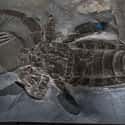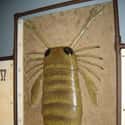-
(#1) Their Claws Could Be Over 19 Inches Long
The Jaekelopterus rhenaniae species of eurypterids, nicknamed "Jake," had a pincer claw measuring a half-meter. For those who don't follow the metric system, that is over one-and-a-half feet long! Paleontologist Markus Poschmann found the fossilized claw in a quarry in Germany, almost inadvertently while on a random hunt for other fossils in 2010.
Poschmann's crew was removing sediment from ancient slabs of siltstone at the bottom of a body of water, and Poschmann noticed "a dark patch of organic matter." This matter turned out to be an appendage used to gouge fish and snatch up other sea life. Some think such fish developed thicker exoskeletons as an evolutionary response to Jake's claws and hunting style.
-
(#3) They Could Grow Larger Than An Adult Human
Eurypterids are thought to be the largest arthropods ever to have existed. The biggest may have exceeded eight feet in length, making them larger than the average height of an adult human. These creatures got around on eight primary legs with two paddle legs on their rear, which they used to swim in the muddy shallows during the Paleozoic Era.
These creatures were not only tall, but they likely had an impressive girth as well.
-

(#12) They Are Now Extinct
Eurypterids lived for about 200 million years. However, like many other prehistoric creatures, they are now extinct. One possible reason for their extinction is their prey could have evolved to protect themselves with thicker skin and stronger jaws. Unable to compete in an ecosystem they once dominated, the beasts were potentially forced onto land where they had to adapt and consequently decreased in size over time.
Giant scorpions most likely ceased to exist during the Permian mass extinction, when close to 90% of life on Earth perished due to toxic rain caused by extreme volcanic activity. Fortunately, at no point in time did they coexist with human beings.
-

(#8) They Were Perhaps Fierce Predators
Given the creatures' size and claws that protruded in front of their mouths, experts once thought eurypterids were top predators. They had the advantage of being able to quickly swim through the water, as they relied on fish and other sea life for sustenance.
This hypothesis appears more likely to be applicable before eurypterids' prey began to adapt and develop better defense mechanisms. Other research suggests eurypterids were bottom feeders that preyed on soft-skinned animals along the sea bed. Despite their massive size, later generations of eurypterids lacked good eyesight, making it difficult to swiftly pick off other creatures.
-
(#2) They Adapted To Live On Land And In Water
Some eurypterids had the ability to breathe while in water and on land. One of the first animals to make the evolutionary leap from sea to shore, they periodically left the safety of their shells. Like other arthropods, these sea scorpions had exoskeletons that they could shed.
Since eurypterids' legs were designed for swimming, when they were on land, they likely had a difficult time moving around. The water might have restricted larger varieties because their legs could not support their body weight on land.
-
(#6) They Lived In Prehistoric Craters
A large fossil bed containing the remains of over 100 eurypterids was discovered in a meteorite impact crater near Decorah, IA. Such craters were created about 460 million years ago when the planet was pelted with incoming meteorites.
As the millennia passed, these craters filled up with water and became seas that offered an ideal habitat for sea scorpions.
New Random Displays Display All By Ranking
About This Tool
The sea scorpion is a kind of ancient sea creature with a body length of 1 to 2 meters. It existed on the earth 500 million years ago and a giant among arthropods. Fossils of giant sea scorpions have been found in the United Kingdom and the United States, the largest and oldest sea scorpion fossil ever discovered was unearthed in Iowa.
The sea scorpions have sharp and slender arm-length claws that can grab the prey and push it into their mouths. This is obvious that the sea scorpion is a very aggressive animal. You could learn 13 facts about the sea scorpion with this random tool.
Our data comes from Ranker, If you want to participate in the ranking of items displayed on this page, please click here.













